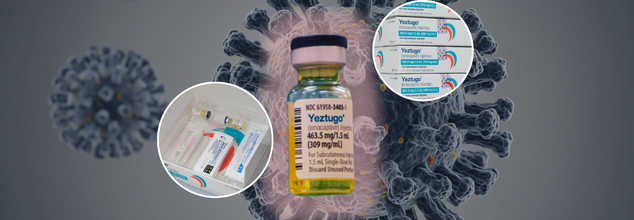- Health Conditions A-Z
- Health & Wellness
- Nutrition
- Fitness
- Health News
- Ayurveda
- Videos
- Medicine A-Z
- Parenting
- Web Stories
'I'm Too Young For Cancer' Young Breast Cancer Survivor Details Her Survivor Story

(Credit-American Cancer Society)
Cancer often seems like a distant issue, you may hear about other people experiencing it, however, getting a diagnosis yourself can be difficult to imagine. It was the same for Drea Sauceda. A young mother of two, Drea, had made an immediate appointment with her doctor when she felt a lump in her breast. Although she had brushed it off as paranoia initially, the reaction of her healthcare professionals led her to realize that this is in fact serious.
Shocking Diagnosis
When Drea Sauceda found a lump in her breast in December 2021, she just told herself, "It's nothing. I'm too young for cancer." Even though she thought she was overreacting, the 39-year-old mom of two quickly made an appointment. But as she waited for her test results, it became clear things were serious.
After her mammogram and ultrasound, Drea remembers them asking if she'd ever had a biopsy. It felt like a strange question. Then, her nurse rushed to schedule an MRI right away. "It slowly started hitting me that this was going to be serious," Drea said. The very next day, the phone call came with the awful news: she had HER2-positive breast cancer.
Navigating Emotional Challenges
Early on, Drea found it really hard to tell her friends, family, and co-workers about her cancer. Most people were shocked and sad, which was understandable. But it took a lot of her own energy to deal with their emotions again and again.
"I'm the type of person who never wants to make anyone uncomfortable or sad," Drea explained. "I really hated telling people. I'd ask my husband, my mom, or my sisters to do it." She found herself crying more about having to tell others and seeing their reactions than she cried about the diagnosis itself. "The social side of getting cancer is so strange," she added.
Documenting the Treatment Journey
At first, Drea's treatment plan didn't include chemotherapy. But after more tests, her doctor recommended surgery (a lumpectomy and breast reduction), followed by 12 weeks of chemotherapy, and then radiation. Learning she'd need chemo made Drea very worried. She looked online for others' experiences to know what to expect. But she couldn't find the kind of everyday, personal stories of treatment she was looking for.
"The doctor gives you a list of side effects you can expect, but I wanted to know what happens to people and how they'd describe it themselves," she said. "I wasn't finding that online, so I decided to write it myself."
Drea started writing weekly blog posts, sharing every appointment, symptom, and side effect. She started the blog to help others, but it also helped her understand her own journey, especially as treatment became very tough. Drea said her body reacted badly to her second-to-last round of chemo, and she spent most of that week bloated and in pain.
"I couldn't even get comfortable lying down," Drea said. "It was to the point where I was almost ready to say, that's it, I'm done, I'm not doing the last dose."
Celebrating a Milestone And New Set Of Challenges
Despite the immense discomfort, Drea pushed through to complete her treatment. She marked this significant milestone by participating in her local Relay For Life. What she hoped would be a "victory lap" turned into a joyous celebration.
Even though Drea finished her treatment with a celebration, the good feelings didn't last long. For so long, she had a clear plan and a busy schedule of daily appointments. But when treatment ended, life slowed down and became quiet. Soon, she found herself struggling with a strong fear that her cancer would come back, along with other health worries.
"I'd find myself in the waiting room at my primary doctor's office for a routine six-month check, and I'd start crying," she said. "During treatment, you're powering through. You're being strong. But when it's all supposed to be over, the trauma hits, and you start thinking things like, what will I do if it comes back? Am I going to get to see my girls grow up?"
To help her with these feelings, Drea joined several cancer survivor groups. Talking with others who had similar experiences helped her realize this is a common struggle. Cancer survivors often face mental health issues even after the physical signs of cancer are gone, and the people who supported them during treatment go back to their normal lives. Drea said a few things have helped her cope after cancer: antidepressant medicines from her doctor, regular talks with a therapist, and breathing exercises to calm her body and mind when panic sets in.
"I take deep breaths, take myself out of fight or flight, and think through things logically," Drea said, “Cancer is horrible, and not everyone has a good outcome," she said. "But to meet those amazing ladies and be celebrated in such an uplifting way, that was an amazing experience."
FDA Approves HIV Shot That’s 99.9% Effective; Is This The Beginning Of The End For The Viral Epidemic?

Credits: AP
The U.S. Food and Drug Administration (FDA) approved Yeztugo, a powerful, long-acting injection developed by Gilead Sciences, as a twice-yearly preventive treatment against HIV. The move has ignited widespread hope among global health advocates, signaling what many believe to be the dawn of a new era in HIV prevention.
With a 99.9% success rate in preventing HIV transmission in clinical trials, this injectable therapy formally known as lenacapavir, offers a revolutionary alternative to daily pills and could dramatically reshape the global HIV landscape.
Why Is HIV Drug Approval Such a Big Deal?
For more than 40 years, HIV has eluded a vaccine. While treatment has transformed HIV into a manageable chronic condition for millions, preventing new infections has remained a formidable challenge. Daily oral PrEP (pre-exposure prophylaxis), such as Truvada, has helped, but adherence is difficult for many especially in vulnerable populations.
That’s where Yeztugo changes the game. Its unique mechanism, longevity, and ease of use have the potential to overcome the barriers of daily pill regimens. Administered once every six months by a healthcare provider, it’s the longest-lasting PrEP option ever approved.
“This is a historic day in the decades-long fight against HIV,” said Daniel O’Day, CEO of Gilead Sciences. “We believe this marks a turning point.”
How Does Yeztugo Work?
Lenacapavir is not a vaccine. Instead, it is an antiretroviral that blocks HIV from infecting immune cells and replicating. What sets it apart is its ability to stay in the body for extended periods, providing protection for six months with a single shot.
Gilead conducted two major trials to test the drug’s efficacy in over 2,000 cisgender women in sub-Saharan Africa, the injection showed 100% prevention of HIV infection.
A parallel trial involving men who have sex with men and gender-diverse individuals showed a 99.9% effectiveness rate, with only two breakthrough infections. These outcomes, published in The New England Journal of Medicine, led Science to name lenacapavir its 2024 “Breakthrough of the Year.”
Reported side effects were minimal, limited mostly to injection site irritation, headaches, and nausea.
How The New Drug Affects HIV Treatment And Prevention?
Interestingly, lenacapavir didn’t start as a preventive drug. It was initially approved in 2022 (under the brand name Sunlenca) for treating drug-resistant HIV.
Researchers at Gilead quickly recognized two features that made it ideal for prevention: its long half-life and its ability to disrupt multiple stages of the HIV life cycle.
“We saw a fantastic protective effect after just one injection—even in non-human primate studies,” said Tomas Cihlar, Gilead’s VP of Virology. “That’s when we realized we had to pursue prevention aggressively.”
Could This Replace HIV Vaccine?
In many ways, yes—at least for now. While lenacapavir isn’t a vaccine in the traditional sense, its efficacy closely mimics one. And since traditional HIV vaccine development has repeatedly hit roadblocks, some experts believe lenacapavir may be the next best thing.
“Lenacapavir used by itself for prevention is a huge breakthrough,” said Dr. David Ho of Columbia University, a pioneer in HIV research. “Its potential to curb the epidemic is enormous.”
Yet ironically, the drug’s success could make it harder to develop a conventional vaccine. Why? Because it would now be unethical to assign people a placebo in vaccine trials when such a highly effective alternative exists.
Is There A the Catch?
While the science is exciting, several real-world challenges could stand in the way of Yeztugo’s success, cost, access, and policy chief among them.
Previous injectable PrEP options like cabotegravir, approved in 2021, came with hefty price tags and have yet to make a meaningful global impact. Gilead has not yet announced pricing for Yeztugo, but there’s concern it may follow suit.
Additionally, logistical barriers remain. Yeztugo must be administered in a clinic by a healthcare provider and requires that recipients test negative for HIV before each shot. That’s a significant hurdle for high-risk individuals in low-resource settings.
“There’s huge promise here, but we’ve built a jet without a runway,” said Hui Yang of the Global Fund to Fight HIV, TB, and Malaria. “If we don’t address distribution, affordability, and systemic barriers, the science won’t matter.”
Who Gets Access To HIV Injection?
Gilead has signed royalty-free licensing deals with six manufacturers to produce lenacapavir generics in 120 low- and middle-income countries. But critics point out that many middle-income nations, such as some in Latin America, are left out.
Meanwhile, in the U.S., states with strong support for PrEP programs have already seen a 38% decline in HIV infections. In contrast, states without similar support saw a 27% increase, according to The Lancet HIV.
With Medicaid cuts looming and the Supreme Court considering a case that could overturn the requirement for insurers to cover PrEP without copays, the long-term reach of Yeztugo may be compromised.
“We could be standing on the verge of eliminating new HIV infections,” said Carl Schmid of the HIV+Hepatitis Policy Institute. “But without the right policies, this will remain a medical miracle out of reach for too many.”
What Comes Next In the HIV Battle?
Gilead is already working on a once-a-year formulation of lenacapavir to make prevention even more accessible. The Global Fund aims to reach two million new PrEP users in the next three years, and Yeztugo could be pivotal to that goal.
There’s also ongoing research into self-administered versions of the injection, which would help reduce the need for in-clinic visits—especially vital for reaching marginalized populations.
The FDA’s approval of Yeztugo is more than a regulatory milestone—it’s a paradigm shift in HIV prevention strategy. Whether this breakthrough can live up to its promise will depend on how quickly and equitably it can be delivered.
Can Wildfires Increase The Risk Of COVID-19 And Flu?

Credits: Canva
When wildfires rage, the first and most visible impact is on air quality. Thick, smoky skies push people indoors to avoid breathing in the hazardous particles. But a new study warns that this very move—to stay safe from smoke—could make people more vulnerable to contagious respiratory illnesses like influenza and COVID-19.
The findings, published in PLOS Climate by researchers from Georgetown University, suggest that increased indoor crowding during wildfire events could create the perfect storm for airborne viruses to spread more easily.
What the Study Looked At
To understand this link, researchers used anonymized mobile phone data tracking visits to more than 4.6 million locations across the United States—ranging from parks and trails to malls and restaurants. They focused particularly on the 2020 wildfire season in Oregon and Washington, when large-scale fires blanketed the states in thick smoke between July and November.
Air quality data helped identify the counties hit hardest. The researchers then compared changes in people’s movements before, during, and after the wildfires.
People Headed Indoors—and Stayed There
The analysis showed a clear shift: as the wildfires worsened, people sought refuge indoors.
- In Oregon, indoor activity jumped by 14%.
- In Washington, it rose by nearly 11%.
- Major cities like Seattle and Portland saw even bigger increases—16% and 11%, respectively.
More time indoors means more shared air—and a greater chance for viruses to spread among those sharing that space.
Why This Matters for Flu and COVID-19
Respiratory viruses like the flu and COVID-19 thrive in enclosed environments, especially where ventilation is poor and people are in close contact. The researchers used computer models to estimate the likely increase in infection rates caused by this behavioral shift.
Their findings? Crowded indoor spaces during wildfire events could significantly boost peak infection numbers—unless precautionary measures are taken.
Masking Can Make a Difference
Fortunately, there’s a simple step that could help counter this risk: mask-wearing indoors.
“Even a modest increase in mask use—just 10%—can help reduce the peak of infection during wildfires,” the researchers wrote. In some places, like Washington County in Oregon or Yakima County in Washington, more robust measures (over 50% masking rates) may be needed to truly reduce transmission.
Planning Ahead for a Warming World
As wildfires become more frequent and intense due to climate change, public health officials must start thinking ahead—not just about air quality but also about how people behave in response.
“Our study shows that emergencies like wildfires don’t just affect the environment—they also change how we live day to day,” said lead researcher Giulia Pullano, a postdoctoral fellow in epidemiology. “If we understand that, we can prepare better.”
In short: what protects us from wildfire smoke might leave us exposed to something else. But with awareness and action, communities can stay safe on both fronts.
Asthma Risk Could Increase For Women Who Work Night Shifts: Study

(Credit-Canva)
As our economy and connectivity evolved, many companies and professionals have moved onto working 24/7. To make this happen, people have come up with shift schedules that will allow some people to work during the day, while others work night shifts. However, an issue people face is that night shifts are unconventional and can impact your health. It changes the way your body functions and can have a severe impact on your body.
A study published on June 16 in ERJ Open Research found that women who consistently work night shifts have a 50% increased risk of moderate to severe asthma compared to women who workday shifts. Interestingly, this connection wasn't observed in men.
Researchers from the University of Manchester in the U.K., explained that while the study doesn't pinpoint why this link exists, it might be due to disruptions in the body's natural clock, which can affect hormone levels.
Hormonal Connections and Increased Risk
The idea that hormones play a role is supported by a key finding: postmenopausal women on the night shift who were not using hormone replacement therapy (HRT) saw their risk of moderate to severe asthma nearly double.
Researchers noted that asthma already affects women more severely than men, leading to higher hospitalization and death rates for women. Previous studies have also linked night shift work to more severe asthma in general. This led the team to investigate if night shifts would further increase asthma risk specifically for women.
Study Details and Findings
The study tracked the health of nearly 275,000 working individuals in the U.K. Biobank, a large health research project. Over 5% of these workers had asthma, with 2% suffering from severe asthma requiring a rescue inhaler.
The results clearly showed that women working only night shifts had 50% higher odds of moderate to severe asthma. This risk jumped to 89% higher for postmenopausal women on the night shift who were not taking HRT.
Researchers suggested that HRT might offer some protection against asthma for night shift workers, but he stressed that more research is needed to confirm this. He also speculated that higher testosterone levels in men might protect them from asthma, as testosterone has previously been linked to asthma protection.
Unanswered Questions and Future Steps
While the study highlights a strong association, it can't definitively prove that night shifts cause asthma in women. Other factors, like the different types of jobs men and women hold on night shifts, could also contribute to the risk.
Experts pointed out that it's often not easy for workers to simply change their shifts. She emphasized the need for further research to fully understand this link and to find ways to reduce the risk for women who work night shifts.
What Are Some Other Long-Term Effects Of Night Shifts?
Shift work, especially at night, seriously disrupts your body's natural 24-hour cycle, called the circadian rhythm, leading to various health challenges. Here are some long-term health issues that may arise from it, according to UCLA health.
Cancer
Disrupted circadian rhythm impacts cell function, DNA repair, and cell death, potentially leading to cancer, as reported by the National Toxicology Program. Reduced melatonin from irregular light/dark exposure hinders cell repair, making cancer progression easier.
Cardiovascular Disease
Working unusual hours increases heart disease and stroke risk. A European Society of Cardiology-linked study found women with five-plus years of rotating night shifts faced higher death risk, tied to stress, high blood pressure, and metabolic factors.
Gastrointestinal Disorders
Shift workers often experience digestive issues like abdominal discomfort, constipation, diarrhea, and IBS. These gut problems stem from sleep deprivation and unhealthy, processed food diets common in shift work, altering gut bacteria.
Mental Health Disorders
Nonstandard hours make maintaining relationships difficult, leading to isolation, stress, depression, and anxiety. A large study in The Lancet Psychiatry found shift work directly linked to higher risks of depression and anxiety, increasing with shift frequency.
Metabolic Disorders
Shift work disrupts circadian rhythm and hormones, raising risks for obesity, metabolic syndrome, and Type 2 diabetes. It's linked to higher BMI, hormonal imbalances affecting appetite/weight, and unhealthy lifestyle choices like smoking and poor diet.
© 2024 Bennett, Coleman & Company Limited

